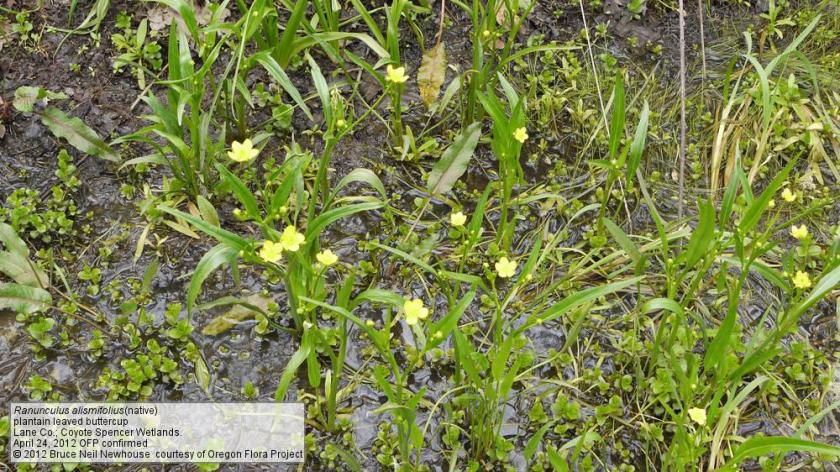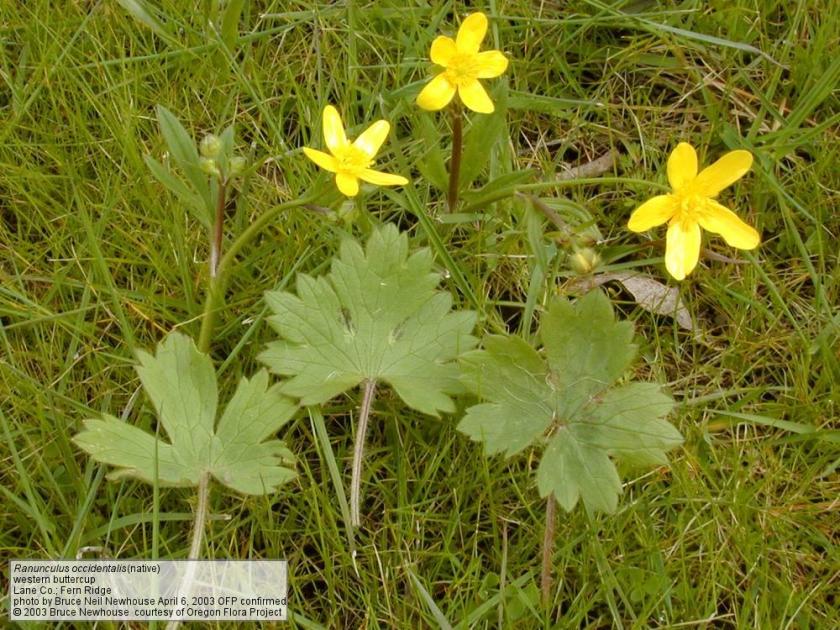Ranunculaceae – Buttercup Family
The Ranunculaceae are representative of early evolved flowering plants, much like Magnolias, and this can be understood when looking at Buttercup flower parts.[i] Unlike families that arose in more recent evolutionary time, the flowers of this family display ancestral characteristics – all perianth (petals plus sepals) and reproductive parts of are all distinct and not fused in any way. Moreover, reproductive parts are often of an indefinite number as compared to other families with predictable numbers of three, four, or five-merous stamens and pistils.[ii] In this way, botanists declare members of the Ranunculaceae to have “simple” flowers, however this label does not dictate that they do not display highly intricate forms. Columbines, Delphiniums, and Clematis are all members of this family, yet all appear to display incredibly elaborate blossoms as a result of coevolution with their pollinators.[iii]
Almost all in this family are herbaceous forbs (some vines), with alternate cauline (along the stem) and/or basal leaves which are usually compound or deeply lobed, but can also be simple.[iv] Sepals can number 2 to 5, sometimes appearing showy and petal like. Petals are sometimes absent, or are in sets of four or more.[v] Generally, numerous stamens are preset (think of the many stamens in a garden variety Anemone) while there are almost always more than one pistil (like the pistils emerging from the nodding head of a columbine flower). All flower parts are separate from each other but attached to the plants’ superior ovary. Fruit morphology is diverse in this group. Some genera produce a head of many dry achenes with small hooks helpful zoochory (seed dispersal on animals) in as in Ranunculus species in local wetland and upland prairies. Others like many Clematis produce long, skinny achenes arranged in conspicuous spirals along their vines. Even more members of this family develop many capsuled follicles, as in the case with Nigella, a species used in floral arrangements for its uncommon appearance.
Over 2,000 species and 43 genera of Ranunculaceae are distributed around the world, with about 23 genera found in North America.[vi] The name Ranunculaceae comes from Latin’s “ranunculus” (little frog) or just “rāna” (frog) thinking that since many species are found in or near water, they are like frogs.[vii] Many in our area are perennial and early blooming nectar species needed by native pollinators,
Ranunculus orthorhynchus var. orthorhynchus – Straight Beak Buttercup
 Species Code: RAOR
Species Code: RAOR
Habit: Perennial herbaceous forb growing 20 to 80 cm tall with five, lemon yellow showy tepals that fall away to reveal a sphere of spiked, or beaked, achenes resembling a bird’s head in profile.
Leaves: This plant has three types of leaves – basal, mid-stem (cauline), and upper leaves immediately below flowers. Rounded, basal leaves are 3 to 8 cm long and divided into 5 to 7 deeply cleft, dissected leaflets.[viii] Some of these basal leaves are more finely dissected than others. Mid-stem, cauline, leaves are linear, more shallowly lobed with relatively shorter leaf stalks.[ix] Uppermost leaves are sessile (no petiole) and just below flower clusters. These are narrowly three parted, with middle lobes longer than the others.[x] Leaf pedicels are distinctively soft and hairy, as are basal leaf surfaces.[xi]
Stems: Plants have several slender, erect or drooping stems that are usually branched and can have a greenish-purple tinge.[xii]
Flowers: Long narrow pedicels can be up to 15 cm long. Five sepals are yellowish and bend slightly backwards (reflexed). Five oval, glossy, petals range from 9 to 18 mm long, are bright yellow, sometimes with reddish orange streaks along their back.[xiii]
Fruits: Blooming early in the spring, these petals fall off early as well, but retain ball of seed heads into early summer. Each seed head contains 20 to 50 dry achenes. Most buttercup species have curved beaks on their achenes, similar to a parrot’s hooked beak. In contrast, R. orthoryhynchus rounded achenes (3.5 mm long) with straight beaks that are 2.5 to 4.4 mm long.[xiv]
Ecology: Facultative Wetland Species (FACW), a hydrophyte that occurs mostly in sites that are wet in spring but dry by late summer and tolerates dryer areas.[xv]
Notes: May be confused with a number of other buttercup species in these habitats. Particularly, Ranunculus occidentatlis, Western Buttercup.[xvi] Straight Beaked Buttercup is distinguished from R. occidentalis, not only by the moisture gradients it is found in (R. orthoryhynchus grows in wetter areas relative to dryer Western Buttercup), but because basal leaves and pedicles of R. orthoryhynchus are hairy where Western Buttercup are not.[xvii] Moreover, the dry achenes of R. orthoryhynchus have straight, sharp beaks and occidentalis are curved like a parrot’s beak.[xviii]
Ranunculus alismifolius – Plantain-leaved Buttercup
Ranunculus occidentalis – Western Buttercup
[i] Simpson, M. Plant Systematics 2nd ed. Academic Press, Burlington, MA. 2010.
[ii] Elpel, T. J., Botany in a Day: The Patterns Method of Plant Identification. HOPS Press, 2004. 43
[iii] Simpson, M. Plant Systematics 2nd ed. Academic Press, Burlington, MA. 2010.
[iv] Pojar, J., Mackinnon, A., Editors Plants of the Pacific Northwest Coast. Lone Pine Publishing, Vancouver, Canada. 2004. 170
[v] Gilkey, H. Handbook of Northwestern Plants, Revised Edition. Oregon State University Press; Corvallis, OR. 2001. 144
[vi] Simpson, M. Plant Systematics 2nd ed. Academic Press, Burlington, MA. 2010. 280
[vii] Quattrocchi, U. CRC World Dictionary of Plant Names: Common Names, Scientific Names, Eponyms, Synonyms, and Etymology. CRC Press, Boca Raton. 2000.
[viii] Gilkey, H. Handbook of Northwestern Plants, Revised Edition. Oregon State University Press; Corvallis, OR. 2001.
[ix] Guard, J. (1995). Wetland Plants of Oregon and Washington. Lone Pine Publishing, Edmonton, Alberta. 110.
[x] Guard, J. (1995). Wetland Plants of Oregon and Washington. Lone Pine Publishing, Edmonton, Alberta. 110.
[xi] Pojar, J., Mackinnon, A., Editors Plants of the Pacific Northwest Coast. Lone Pine Publishing, Vancouver, Canada. 2004
[xii] Guard, J. (1995). Wetland Plants of Oregon and Washington. Lone Pine Publishing, Edmonton, Alberta.
[xiii] Gilkey, H. Handbook of Northwestern Plants, Revised Edition. Oregon State University Press; Corvallis, OR. 2001.
[xiv] Hitchcock et al. 1955-69
[xv] USDA Plants Database: <https://plants.usda.gov/core/profile?symbol=RAOR>
[xvi] Gilkey, H. Handbook of Northwestern Plants, Revised Edition. Oregon State University Press; Corvallis, OR. 2001.
[xvii] City of Eugene, Seed Collection Maual, Ranunculus orthorhynchus, 2009.
[xviii] City of Eugene, Seed Collection Maual, Ranunculus orthorhynchus, 2009.
